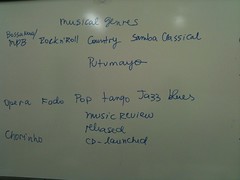Add to design the learner himself. The third level. Many times, we simply take for granted how the learner is dealing with his learning process. We, as educators, need to make them aware of learning strategies that might work for them, that might help them take their language production to the next level. It is all about helping them design their own learning paths through tips, suggestions and constant support.
This is an example of what I generally do. I take a picture of our collective work on the board and post it on our class wiki. However, my handwriting is not a masterpiece on the board. It might be helpful for students, but not that visually-appealing:

Let's turn this option more student-centered and well-designed to help students explore class content more effectively.
Take, for example, a site like http://squareleaf.net/. It is very simple to register, students can add their class entries in a color-coded fashion. It is a clean, straightforward, ad-free online space. Students gain in mobility as they can access their notes wherever they are. Plus, they are the ones creating their language lists in any way they feel might be more profitable for them, including editing the colors for each box. So, here's the twist from my previous image:
What do you think? How might this affect the whole learning process? Isn't it going to help in our students' own learning design?


No comments:
Post a Comment
Conversations are sparklers for deepening thoughts and maturing ideas. Share, connect, leave a comment. I'd love to hear from you. To follow up on the comments here, click on the "subscribe via email" below the comment box, on the right.